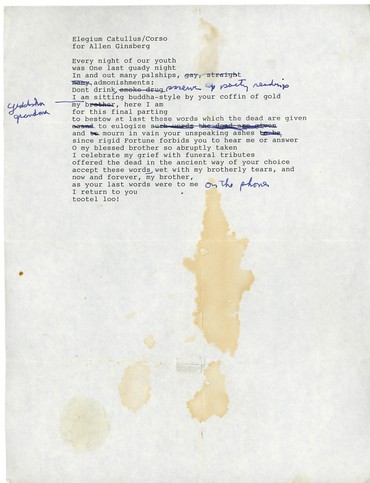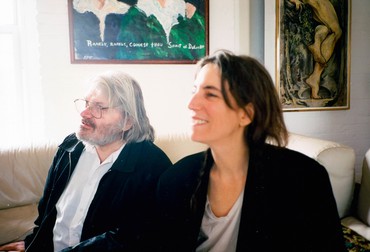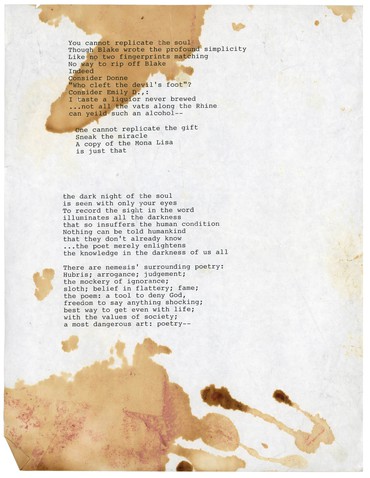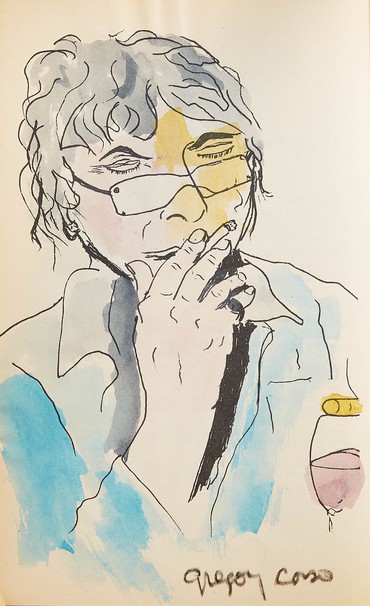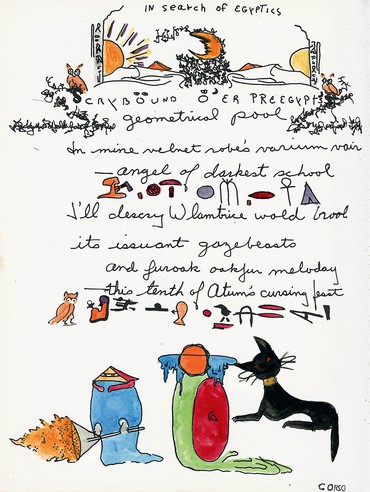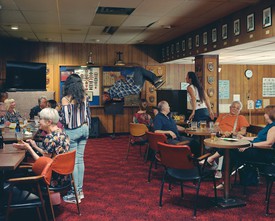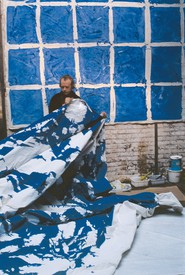
Raymond Foye is a contributing editor to the Brooklyn Rail. His most recent publication is Harry Smith: The Naropa Lectures 1989–1991 (2023). Photo: Amy Grantham
This is how it happened:
At the end
everything that was
dwindled into a dot;
the dot exploded into the void
and the beginning began again—
—Gregory Corso, from “The Golden Dot,” c. 1998
Time, cosmic and terrestrial, was one of Gregory Corso’s great subjects. He saw the decades as distinct parcels, the centuries as larger ones, and millennia more so. Throughout the 1990s he had been eagerly awaiting the arrival of the millennium, exploring in his poems themes of Armageddon and apocalypse, ecological cataclysm, Revelations, and the promise of a New Age. But as the momentous date approached, personal tragedies mounted: the death of his closest friend and literary champion, Allen Ginsberg, in the spring of 1997, followed four months later by the death of William Burroughs, his second-oldest friend and the person he considered most incorruptible in life. Then came news of liver, heart, and lung disease, and finally inoperable prostate cancer. He managed to see the new millennium, but only just. He left his beloved Greenwich Village for the care of his daughter’s home in Minnesota in 2000, and died there shortly thereafter, on January 17, 2001.
Corso had struggled with his final manuscript, The Golden Dot, for the last twenty years of his life. It went through countless visions and revisions, both textual and conceptual. He knew it would be his poetical last will and testament. It had to be precisely on the mark, a summation of the many literary and philosophical themes that preoccupied him in life. Even more daunting than the personal hardships (which were nothing new to him), he had changed his fundamental approach to the poem, casting off an elaborate stylistic toolkit that no longer served his purpose. The rudiments of the poem were what mattered now, a direct and elemental relationship with the Muse. Frustratingly, throughout the 1990s, the project continually collapsed under its own weight . . . until.
Following Ginsberg’s funeral at New York’s Shambhala Meditation Center, Corso returned to his small apartment at 26 Horatio Street in the West Village and composed “Elegium Catullus/Corso, for Allen Ginsberg.” It is modeled on a funeral ode by the Latin poet Catullus, as he sits next to and addresses the “unspeaking ashes” (alloquerer cinerem) of his brother. Corso lightens Catullus’s famous final line, Ave atque vale (Hail and farewell), with the salutation he and Ginsberg always used on each other, “Tootel loo”—a bit of ’50s camp silliness. With this short and simple poem, the floodgates opened. Over the next three and a half years Corso rewrote the entire manuscript of The Golden Dot, two hundred-plus pages, beginning that evening with this simple elegy.
The Golden Dot is framed by Ginsberg’s death on one end and Corso’s own death on the other. It is, among other things, the story of a lifelong friendship between two of the greatest poets of the twentieth century. Corso is now alone, left to argue with his mentor and rival, pleading his case and making amends. His insecurities lead him to question the very reasons Allen befriended him in 1950 in a Greenwich Village bar in the first place: Was it just his good looks and street smarts? But he comes to trust and accept Allen’s estimation of his work, so succinctly stated on the dedication page of Planet News (1968), some of the only serious recognition he ever got for his poetry in his lifetime: “Dedicated to the Pure Imaginary poet Gregory Corso,” and once again in Ginsberg’s Selected Poems 1947–1995: “To Gregorio Nunzio Corso, Wisdom Maestro, American Genius of Antique and Modern Idiom, Father Poet of Concision.” Allen always told anyone who would listen that Gregory was the greater poet, and often lamented the lack of serious critical evaluations of Corso’s work.
Corso did not like to overpublish, and by the 1960s one book per decade became his general rule, usually at the turn of the decade, with each book expressing something of what he felt to be the zeitgeist of the moment: The Happy Birthday of Death in 1960; Elegiac Feelings American in 1970; Herald of the Autochthonic Spirit in 1981. Another rule was that the books should be brief: these were 92, 120, and 66 pages respectively. But by the time 1990 arrived, Corso chose not to publish. He turned fifty that year, and while his reasons for not publishing were never clearly stated, profound changes were taking place in his life and work since “Hitting the Big 5-0,” as he called it in a poem marking the occasion. Corso’s relationship to poetry had been a trajectory from intensely private to famously public, sometimes reading to audiences of a thousand or more. He complained to me often, “I began writing poetry alone, after midnight, just me and the poem, by candlelight. The next thing I know I’m onstage reading to hundreds of people. It messed me up.” This led Corso to favor humorous poems, crowd pleasers with punchlines. He’d come to see himself as a performer, a clown, even, in his own words. He had been on the reading circuit for twenty-five years, often touring with Ginsberg—they were public poets in a way that is almost unimaginable today, and they both took that role very seriously. But Corso’s brash persona and drunken antics at readings masked a painful shyness, and he longed to escape that grind. As he so memorably put it in a poem of the time, “I feel like an old mangy bull crashing through the red rag of an alcoholic day.” He’d come to see this public face of poetry as a routine, a job, an act. And while he may have had many shortcomings, being dishonest with himself was not one. Slowly, he withdrew.
These had been hard years. The drinking itself was no longer sustainable, and that necessitated an increasing withdrawal from society. More profoundly, the half-century mark awoke in him the need to confront the many traumas that haunted his adult life: abandonment by his mother shortly after his birth due to domestic abuse by his father; six cruel Catholic foster homes; frequent prison time, starting in the Tombs at the age of thirteen. The orphanages and prisons had always been part of his personal mythology, but until this point the painful details had never been publicly examined or revealed. And once that door was opened in his writing, it could not be closed.
Corso was a native New Yorker, born on the corner of Bleecker and MacDougal Streets. It annoyed him when people talked about the Beats hanging out in Greenwich Village: “I wasn’t hanging out. I was born there.” Gangsters frequented the cafés and restaurants, and the culture of organized crime was hard to resist. From individual acts of petty theft, Corso eventually became the ringleader of his own larceny gang, whom he organized with walkie-talkies. At the age of seventeen he was sentenced to three years in upstate New York’s brutal Clinton Correctional Facility, known as Dannemora. Ever the prodigy, he often noted that he was the youngest inmate to enter that prison and the youngest to leave.
There’s a remarkable film of Corso on a return visit to Dannemora Prison (as he always called it) two years before his death, speaking with prisoners about writing poetry. He recounts the advice an old inmate gave him the day he arrived: “Don’t serve time, make time serve you.” The prison library held few books but they were choice: The Shorter Oxford English Dictionary, the Bible, the Encyclopedia Britannica (eleventh edition), Bulfinch’s Mythology, and a 1925 anthology titled Ideas and Forms in English and American Literature, edited by Homer Watt and James Munn. I recently ordered a copy of the latter for a few dollars on the Internet, after finding Corso’s reference to the book in the manuscript of The Golden Dot. It’s a fascinating selection and explains a great deal about his penchants for early epics such as Beowulf and Sir Gawain and the Green Knight, and for the ballads of the British Isles, such as “The Twa Sisters” and “Sir Patrick Spens.” Running through all of Corso’s work is a healthy mistrust of literacy and the written word, which he considered latecomers to his profession. The stories and beliefs handed down from ancient times were his true guides, and he always said his favorite author was Anonymous. He loved Sanskrit and Akkadian epics, chronicles of dynastic Egypt, the myths of ancient Greece. His sense of history was synchronous: ideas, events, and subjects rhymed and interconnected inside his head like the gears of a clock.
I first encountered Gregory Corso in April 1973 at a Jack Kerouac symposium at Salem State College in Massachusetts, where he was a featured guest along with Ginsberg and Peter Orlovsky. After a certain amount of debate by the school administrators, the honors English class at Lowell High School was allowed to attend. I was still a junior, but since I was the only student who was actually reading Kerouac, I was allowed to accompany them. The Beats were controversial, but several of the teachers and headmasters at Lowell High had known Kerouac, many had gone to school with him, and personally he was very much liked. The excursion was the idea of our English instructor, Miss Rita Sullivan, a proper elder New Englander—a quality that did not exclude open-mindedness. Alas, the weekend proved a shocking revelation as it quickly dawned on everyone that the poet on the page and the poet in person were two very different things. There was drinking, smoking, cursing, and arguments, and Corso seemed very nearly the devil in the flesh. Were such a thing to take place today, poor Miss Sullivan would be fired and would never get another job as an educator as long as she lived—such is today’s reward for introducing an impressionable youth to the cult of Orpheus.
That weekend, in velvet suit and silver flask of cognac, Corso was on the attack against everyone: Ginsberg, the academics, and Kerouac himself, or at least the myth of Kerouac. (The famed witches of Salem seemed to be the only people he had any respect for.) But then something remarkable happened: the event concluded with an evening poetry reading, and I saw Corso take all of the hostility he had created and suddenly polarize it. (Later I would see performers like Nina Simone and Miles Davis do the same thing.) After ninety minutes of poetry and chanting by Ginsberg and Orlovsky, Corso took center stage and read what I still consider to be his greatest poem, “Elegiac Feelings American (for the Dear Memory of John L. Kerouac).” Suddenly a hushed silence fell on the auditorium as Corso cast his spell; the poem was profound, eloquent, and ravishingly beautiful. At the end of the reading, many in the audience (including Kerouac family members) were weeping, as was Corso himself. There was no question who the heavy was on that stage.
From that point on I was determined to know him, which wasn’t easy because he was hard to find and when you did he was usually unfriendly. Four years later I found myself living in the same neighborhood as him in North Beach, San Francisco. We occasionally spoke. One day he asked if I had a record player, which I did. The next morning he was yelling up from the alley, holding a record in his hand. No album cover, that was lost, just the actual piece of vinyl: a Bartók violin sonata played by Yehudi Menuhin. He came upstairs, we put it on the stereo, and he swooned silently. It was a great lesson in how to listen. He returned for dinner that evening, a gathering of half a dozen poets. In the course of the evening he overturned the table not once but twice: he had a talent for taking it out there, and then some.
One of my favorite things about hanging out with Gregory over the years was watching how he dealt with fans. He had a lot of them, and since he always looked like Gregory Corso, they often approached him on the street. Depending on his mood he might be gracious, but was more often flatly dismissive or downright confrontational, accusing them of pandering and vicariousness—they were the source of his pain. “Mister Corso, I just want to say how much your work has meant to me down through the years,” someone would say in a heartfelt manner. “Do I bother you with my problems?” he would reply curtly. Other times he was more practical: “Oh that’s great, gimme $5.” I can’t count the number of people who came up to him to say that his poem “Marriage” was read at their wedding—a true epithalamium for our times if there ever was one. (The poem is heavily anthologized; Gregory once told me he estimated he’d made over $100,000 from “Marriage”—“Not bad for one poem.”) Especially surprising to me was the number of people who quoted back to him the line “Standing on a street corner doing nothing is power.” Written in 1953, that line somehow represented the quintessentially Beat challenge to authority. And as Gregory often said, one great line is worth an entire book of poems.
Whether Gregory was home alone, playing pool in a bar, or sitting in a café, there was never a time when he wasn’t with the poem, turning a line or image over in his head, speaking it aloud to test the sound and cadence, or questioning the inner logic. I never knew anyone who asked himself so many big questions so relentlessly. At any given time, a scholarly issue was on the table, and he was familiar with them all. In a barroom one afternoon he suddenly slammed the table with his fist and shouted, “It was all because of that damn swan!”—and I knew he was back onto the Trojan War. For Corso, the great subjects of ancient times were not past, but alive in the contemporary painting or poem.
In 1997, his sixty-seventh year, as he labored over his final book, startling news arrived. A documentary filmmaker had discovered his eighty-year-old mother. She had not returned to Italy immediately after his birth, as he had been told, but had merely fled across the river to Trenton, New Jersey, where she raised another family. Their reunion was captured on film, and a few days later they made their first excursion, to an Atlantic City gambling casino—which seemed to establish matrilineal proof beyond doubt. But joking aside, though initially joyous, the reunion only reexposed painful feelings of abandonment. Corso told me a few years later that he wished the filmmaker had left well enough alone. “I lived sixty-seven years without a mother—how can all that be made up for now?” he said. Meanwhile, his father was dying. Although Corso had hated and feared the man all his life, he made the effort to visit him, only to find that Alzheimer’s disease had turned his father into a gentle and kindhearted soul. They had a poignant reunion, but the encounter ended on a painfully embarrassing note: as he left, his father called him Dominic. Life now seemed a daily succession of bewildering events. These and other remarkable events are recorded in The Golden Dot.
One positive development in these years was the emergence of a patron, Hiro Yamagata, a successful visual artist from Japan. His monthly stipend allowed Corso to move out of the apartment of Roger and Irvyne Richards, proprietors of the Rare Book Room on Greenwich Avenue, who had taken him in several years earlier after they learned he’d slept on the subway the night before. When an apartment came vacant next door, Corso had his own living space for the first time in many years. There’s no doubt this helped with the work. Those of us who visited him will recall the floor covered in typed poems, often stained with wine, coffee, blood, and god knows what else. The space also allowed him to begin making art again, which brought in a little money. He was a skilled draftsman with a charming style and a deep knowledge of art history. I regularly commissioned works during this period, requesting portraits of Poe, Whitman, Dickinson, Burroughs, and Bob Kaufman. I also commissioned a hand-colored edition of The Geometric Poem, his paean to ancient Egypt, first printed by Ettore Sottsass in Milan in 1966. He had his visitors and admirers and a calm domesticity prevailed. The one vexation was his addiction. A heroin user since the 1950s, now alternating with methadone, he told me it had been almost twenty years since he’d actually gotten high from the drug—it was simply a matter of maintenance. Veins had collapsed and he was losing use of both arms. Infections led to visits to nearby St. Luke’s Hospital. He recounts these events in several poems, always referring to heroin as “the dirty nurse.”
Corso often spent years revising a poem, and in many respects a poem for him was never finished. Friends who had put him up for days or weeks would later find the books of his in their libraries extensively amended. Poetry readings, especially in later years, often consisted of glosses on the poems; he always seemed to be having a running argument with himself or the poem (they were the same thing). But as the end drew near he seems to have realized these endless revisions would not do, and suddenly we have the rarest of articles in his oeuvre: poems written all at once, in a single stream of thought and inspiration, from start to finish. This is indicated to the reader by the date of composition, and sometimes even the exact time (always in the middle of the night). He called these “diary poems” and he was extremely unsure about them. To me they are the capstones of his career, the works that most show off his extraordinary powers as a poet. To read such poems is to fully enter his mind and to witness the very act of creation. In these last poems he has gone back to the candle, at midnight, writing to himself and the solitary reader. The level of intimacy is exquisite and the effect is ethereal.
Another unusual characteristic of The Golden Dot is how very few poems have titles—perhaps only half a dozen out of almost two hundred. I don’t know why this is, except clearly they were superfluous. One is left with the sense that these are not literary “products” or “objects” but instead a kind of unnameable issuance or outflow. It also facilitates Corso’s wish, stated on page 1 of the manuscript, that this work be seen as a “shuffle poem,” a random, nonhierarchical configuration, or, if one were more occult-minded, a method of divination like the shuffling of the tarot or the throwing of the I Ching. Such a book as this may exist somewhere, but I know of none like it.
Of the many dragons to slay in these last poems, the most pernicious was hubris. “I hate old poet men,” Corso wrote at the outset of his career. Like Pete Townshend’s “Hope I die before I get old,” it was a line he would live to live down. Corso now sees his arrogance (and he was very arrogant) as an obstacle to faith, and to true knowledge. His stance that poetry is the province of the young has had to be exorcised, for he is now an old man and poetry is all he has left. He is emphatic that poetry is for every age. The Golden Dot is a radical coming to terms with old age and failing powers, and Corso’s economy and dispatch are stunning: he knows exactly what to use and what to discard. Dream and myth take over—the places where his Orphic self was most alive.
The reader may ask why, if this book was completed twenty years ago, is it only being published now? After the poet’s death the apartment was cleared out and the manuscript was gathered into a paper shopping bag. In his will, Corso left the rights to the book to his friends Roger and Irvyne Richards, for their faithful support in his final years. Roger Richards, a legendary figure in New York’s rare-book world, died on his seventieth birthday, December 18, 2002. In less than two years, Irvyne had lost her two closest companions in life, and she gradually became a recluse. I called numerous times, hoping to obtain a copy of the manuscript, but she always demurred, saying she wanted to edit the book herself—which I knew would never happen. Irvyne was a chain smoker and for years I lived in fear the apartment would burn down and the manuscript with it. Eventually she stopped taking my calls. The original work remained in her possession, a talisman to a life that no longer existed, and she guarded it against the outside world. When I learned of her death, in September 2020, I called her stepdaughter Hillary and soon the manuscript was in hand. Although some pages had been copied and circulated among Corso’s friends over the years, those were clearly fragments. While not without its share of editorial complications, what we came to possess was a carefully shaped final manuscript, with the author’s intentions plainly evident. After close work with George Scrivani—the poet’s lifelong friend, editor, and translator—the book will soon be published by New Directions, the decisive and concluding chapter of a profound career.

